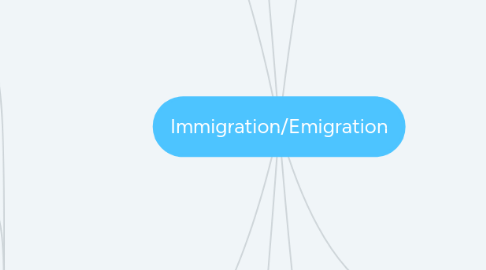
1. Push Factors
1.1. Political
1.1.1. Leaders
1.1.2. Persecution
1.1.3. War
1.1.4. Governments respect/how they treat people
1.1.5. Many Cuban refugees come to U.S. because of government
1.1.6. Escape from persecution from crimes commited
1.1.7. Enslavement
1.1.8. Political agreement
1.2. Enviornmental
1.2.1. Long-term drought
1.2.1.1. Climate change
1.2.2. Crops
1.2.2.1. Ireland lost most potatoes from a fungus causing people to emigrate to U.S.
1.2.3. Human activity
1.2.3.1. Nuclear explosions
1.2.3.2. Pollution
1.2.4. Natural disasters
1.3. Economic
1.3.1. Poor
1.3.2. No known way to improve life
1.3.3. Often farmers
1.3.4. Overpopulation
1.3.5. Natural disasters
1.4. Social
1.4.1. Spreading religion, philosophy, or political movement
1.4.2. Wanting more personal freedom
2. Pull Factors
2.1. Family
2.1.1. Unite separated families
2.2. Education
2.2.1. Kids can attend better schools
2.2.2. Better colleges
2.3. Quality-of-Life
2.3.1. Improve life quality
2.3.1.1. "American Dream"
2.3.2. Safety
2.3.2.1. Wars
2.3.2.2. Persecution
2.3.3. Jobs
2.3.3.1. Afford better food
2.3.3.2. Afford better housing
2.3.3.3. Afford better health care
3. Waves of Immigrants
3.1. 1st Wave
3.1.1. People mostly came from Northern Europe to the U.S.
3.1.2. Escaped from hunger
3.1.3. Escaped from poverty
3.1.4. Some settled in cities
3.1.5. Most found land to farm
3.1.6. Began with the founding of the U.S.
3.2. 2nd Wave
3.2.1. Many were refugees
3.2.2. Fleeing war
3.2.3. Fleeing persecution because of religious beliefs
3.2.4. Most found work in growing cities in the U.S.
3.2.5. Late 1800s
3.3. 3rd Wave
3.3.1. Many Asians moved to West Coast
3.3.2. Many Mexicans moved to Southwest
3.3.3. Many Cubans moved to Florida
3.3.4. New York City attracted people from Caribbean islands
3.3.5. Began late 1960s
3.3.6. Still going on today
3.3.7. 1970-2003 24 million people moved to the U.S.
3.3.8. 75% from Latin America and Asia
4. Migration is Global
4.1. In 2005 191 million people where counted living outside of their birth country
4.2. The number of immigrants has doubled since WWII
4.3. If they lived in the same place they would be the 5th most populous country
5. Effects
5.1. Immigrants
5.1.1. Identity
5.1.1.1. The hyphen effect
5.1.2. Adaptation
5.1.3. Assimilation
5.1.4. Different culture/religious beliefs
5.2. Host Country
5.2.1. Economic
5.2.1.1. Positive
5.2.1.2. Negative
5.2.2. Welfare issues
5.2.3. Social attitudes
5.2.4. Overpopulation/population increase
5.3. Home country
5.3.1. Brain drain
5.3.1.1. Most talented people leave the country for better jobs or communities
5.3.1.2. Can turn into brain gain if people come back with a higher education
5.3.2. Economic
5.3.2.1. Remittances
5.3.2.1.1. Sending money back home
5.3.2.1.2. Helps build towns
5.3.2.1.3. Increase quality of life
5.3.2.2. Loss of revenue
5.3.3. Social
5.3.3.1. Families left behind
5.3.3.2. Population decrease - eventually could become abandoned
5.3.3.3. Use remittances to help family/community
5.3.4. Political
5.3.4.1. Immigrants can come with a higher education increasing the quality of government
5.3.4.2. New political ideas/beliefs
5.4. Multi-Nation
5.4.1. Open border policies
5.4.2. Immigration policies
5.4.3. Security issues
5.4.4. Human trafficking/slavery
6. Affects on the U.S.
6.1. Economic
6.1.1. Jobs
6.1.1.1. Low paying jobs if not much education
6.1.1.2. High paying jobs or starting businesses of high education
6.1.1.3. Some native-born Americans have to compete with immigrants for jobs
6.1.1.4. Generally take smaller jobs that natives don't want
6.1.2. Taxes
6.1.2.1. Immigrants work to pay taxes like everyone else
6.1.2.2. Many immigrants need services that are paid for out of tax money, like language classes
6.2. Cultural
6.2.1. Immigrants bring culture with them
6.2.2. Find familiar foods or bring new foods
6.2.3. New holidays like St. Patrick's Day
6.2.4. Share information about the world
7. Migration
7.1. Voluntary Migration
7.1.1. People choose to migrate
7.1.1.1. In the 1800s Europeans migrated with their own will to U.S.
7.1.1.1.1. 1840s 1.4 million European immigrants moved to U.S.
7.1.1.2. Example: Europeans moved to U.S. after potato crops died in order to find a better life.
7.1.1.3. Hunger can be used as a push factor to leave
7.1.1.4. Escaping slavery
7.1.1.5. Better economy
7.1.1.5.1. More economic opportunities
7.1.1.6. Better life quality
7.1.1.7. More equal treatment
7.2. Involuntary Migration
7.2.1. Being forced to migrate
7.2.1.1. Threats to counrty
7.2.1.1.1. Death or violence
7.2.1.2. Example: Transatlantic slave trade
7.2.1.3. Refugees
7.2.1.3.1. Escaping prosecution
7.2.1.3.2. Fearing prosectution
7.2.1.3.3. No longer protected by their government

